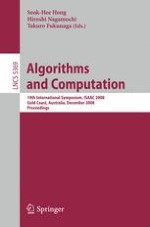2008 | OriginalPaper | Buchkapitel
Navigating in a Graph by Aid of Its Spanning Tree
verfasst von : Feodor F. Dragan, Martin Matamala
Erschienen in: Algorithms and Computation
Verlag: Springer Berlin Heidelberg
Aktivieren Sie unsere intelligente Suche, um passende Fachinhalte oder Patente zu finden.
Wählen Sie Textabschnitte aus um mit Künstlicher Intelligenz passenden Patente zu finden. powered by
Markieren Sie Textabschnitte, um KI-gestützt weitere passende Inhalte zu finden. powered by
Let
G
= (
V
,
E
) be a graph and
T
be a spanning tree of
G
. We consider the following strategy in advancing in
G
from a vertex
x
towards a target vertex
y
: from a current vertex
z
(initially,
z
=
x
), unless
z
=
y
, go to a neighbor of
z
in
G
that is closest to
y
in
T
(breaking ties arbitrarily). In this strategy, each vertex has full knowledge of its neighborhood in
G
and can use the distances in
T
to navigate in
G
. Thus, additionally to standard local information (the neighborhood
N
G
(
v
)), the only global information that is available to each vertex
v
is the topology of the spanning tree
T
(in fact,
v
can know only a very small piece of information about
T
and still be able to infer from it the necessary tree-distances). For each source vertex
x
and target vertex
y
, this way, a path, called a greedy routing path, is produced. Denote by
g
G
,
T
(
x
,
y
) the length of a longest greedy routing path that can be produced for
x
and
y
using this strategy and
T
. We say that a spanning tree
T
of a graph
G
is an
additive r
-carcass
for
G
if
g
G
,
T
(
x
,
y
) ≤
d
G
(
x
,
y
) +
r
for each ordered pair
x
,
y
∈
V
. In this paper, we investigate the problem, given a graph family
${\cal F}$
, whether a small integer
r
exists such that any graph
$G\in {\cal F}$
admits an additive
r
-carcass. We show that rectilinear
p
×
q
grids, hypercubes, distance-hereditary graphs, dually chordal graphs (and, therefore, strongly chordal graphs and interval graphs), all admit additive 0-carcasses. Furthermore, every chordal graph
G
admits an additive (
ω
(
G
) + 1)-carcass (where
ω
(
G
) is the size of a maximum clique of
G
), each 3-sun-free chordal graph admits an additive 2-carcass, each chordal bipartite graph admits an additive 4-carcass. In particular, any
k
-tree admits an additive (
k
+ 2)-carcass. All those carcasses are easy to construct.
